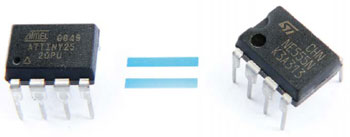Article
All-Soft-555: ATtiny Plays 555 MMV and AMV

The chip with three fives in its type code sure is among the biggest selling ICs of all times, but from today’s perspective, the internal block diagram certainly looks a little dated with its multitude of analogue signal paths. In this article we give the design a 21st-century makeover to produce a much more versatile ‘virtual 555’ using an 8-pin microcontroller.
Materials
Extra info / Update
Features
MMV (iMono) features
Digital, configurable monostable multivibrator
Three modes: non retriggerable, retriggerable and extended pulse
Programmable trigger edge: falling or rising
Non inverting and inverting outputs
Pulse width from 0.8 µs to 524 s
Documented source code in BASIC
AMV (iMulti) features
Digital, configurable astable multivibrator
Four modes: Fast, Fixed value, VCO and VCDC
Gate input defined in software either active High or Low
Waveform true or inverted
Frequency adjustable by software or control voltage
Duty-Cycle adjustable by software or control voltage
Frequency range 10 MHz to 1.91 MHz
Documented source code in BASIC
MMV (iMono) features
Digital, configurable monostable multivibrator
Three modes: non retriggerable, retriggerable and extended pulse
Programmable trigger edge: falling or rising
Non inverting and inverting outputs
Pulse width from 0.8 µs to 524 s
Documented source code in BASIC
AMV (iMulti) features
Digital, configurable astable multivibrator
Four modes: Fast, Fixed value, VCO and VCDC
Gate input defined in software either active High or Low
Waveform true or inverted
Frequency adjustable by software or control voltage
Duty-Cycle adjustable by software or control voltage
Frequency range 10 MHz to 1.91 MHz
Documented source code in BASIC



Discussion (0 comments)
Charles Linquist 1 year ago
A 555 doesn't have to be programmed, an additional step that can be a pain in high-volume applications.
Most versions of the 555 can run on unregulated or poorly regulated voltages up to 15V,and have an output current of 200mA.
Dr. Thomas Scherer 1 year ago
Paulo Soares 1 year ago
Dr. Thomas Scherer 1 year ago
You can use the free version of the BASIC Compiler for this purpose.
Dr. Thomas Scherer 1 year ago
Correct is: Frequency range from 10 mHz to 1,91 MHz.
Small m or capital M makes a factor of 1 million ;-)
Colin55 1 year ago
https://www.talkingelectronics.com/projects/50%20-%20555%20Circuits/50%20-%20555%20Circuits.html
Colin Mitchell
Talking Electronics.com
talking@tpg.com.au